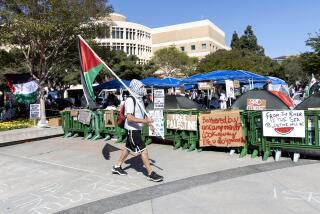Protest May Signal Change at Occidental : Sit-in: Some students are unhappy over the pace of progress, despite the college president’s reform efforts.
- Share via
At first, the bone of contention seemed simple: Occidental College administrators last week canceled a rap concert and graffiti art show that student organizers hoped would attract minority residents and high school students to the Eagle Rock campus.
But by the time more than 150 angry Occidental students began a 1960s-style sit-in at the school’s administration building, the incident had become a symbol of what they perceived as a broader problem.
The cancellation proved that students have no voice in determining how their campus is run, the protesters said. Thus, the sit-in evolved into a five-day vigil over student involvement in campus policy-making.
“Some took the cancellation to be racist; some took it to be isolationist,” senior Jennifer Trochez said. “There was a spectrum of reasons as to why it happened. But when you probed the anger of the students, it all boiled down to the fact that there was no structure for student empowerment.”
The sit-in, which began last Thursday, emerged Monday as the catalyst for a Nov. 28 forum that will include students, teachers and college President John Slaughter.
It also marked what may be a changing climate at Occidental, some students said. Slaughter became president in 1988 and pledged to make the campus more culturally diverse and closely tied to its Northeast Los Angeles community. Occidental, with 1,600 students, is nestled between Glendale and downtown Los Angeles in predominantly Latino Eagle Rock.
But like Soviet President Mikhail S. Gorbachev’s reforms, Slaughter’s agenda may actually have increased dissent among those who wanted change at a faster pace, some students said.
“The whole notion of multiculturalism was spearheaded by Slaughter,” said Stephanie Steele, a senior and member of Student Solidarity, a campus socialist group. “When you start to implement progressive change, you’re going to be confronted.”
The confrontation began after 11 student groups planned an unusual campus event: They invited high school students from Eagle Rock, Highland Park and surrounding communities to hear rap bands, watch mural art demonstrations and visit information tables set up by ethnic organizations.
But on Nov. 13, three days before the event, Dean of Students Brigida Knauer canceled it, citing concerns about potential gang fights and the lack of security.
Knauer said that more high school students than anticipated, some from far away as Bell and South Gate, had been invited and that that threatened to overwhelm the school’s security force and outdoor amphitheater. She said the college would pay the rap groups half of their fees and reimburse student groups for their expenses.
“What it was was an open party to L. A. County,” Knauer said last Thursday. “We’re not gang workers. That’s not what this place is about.”
Knauer and other administrators said student organizers planned the event poorly and miscommunicated details. Many faculty members perceived a flyer for the event--designed by a Highland Park graffiti artist who was helping plan the rap concert--as a cryptic invitation to gangs.
But students were adamant that Knauer’s decision was unjustified. The cancellation, the protesters said, really symbolized an unwillingness by Occidental administrators to work more closely with Northeast Los Angeles communities and develop more cultural diversity--even though Slaughter had determined that both goals were priorities.
“We are tired of participating in the facade of multiculturalism at Occidental,” sophomore Angelique Magliulo said shortly after she and four other students quit their jobs Thursday as peer counselors at the school’s Multicultural Center to participate in the sit-in.
A day later, however, the agenda had broadened. The real problem, students said, was that they had no say in running the campus, no power to hold administrators accountable and no outlet for their grievances.
“Everyone has different reasons for being here and they all have to do with frustration with the administration,” senior David Fuqua said.
Occidental has never been a hotbed for activism. The last major demonstration occurred five years ago when students protested the school’s investments in companies that do business in South Africa, students and administrators said.
But concern over many campus policies and issues--including financial aid, race relations and cultural diversity--and over the students’ inability to hold administrators accountable has been growing for years, Fuqua said.
“The number of students in the sit-in shows the problem is not just an idiosyncratic glitch in the system,” Steele said. “The canceled event was really the straw that broke the camel’s back.”
By Friday night, nearly 40 protesters had decided to remain in the administration building over the weekend to draft a formal list of demands.
One student brought a portable computer; another dedicated his portable speaker and microphone to the cause. Sit-in participants, who were not allowed back in the administration building by campus security guards once they left and developed a courier system.
Meanwhile, several students were assigned to speak to reporters. A pay telephone in the hallway and an emergency telephone in an elevator were used to field calls from the media.
By Monday, the protesters had drawn up their demands: equal representation and equal voting power on all campus committees; yearly evaluations of key administrators such as Knauer by a committee of students, teachers and administrators; nine new student seats on the Board of Trustees; a new process for scheduling campus events, and improved financial aid policies.
The student body president sits on the Board of Trustees as a non-voting member.
Slaughter declined to comment on the demands. But he approved the students’ call for a forum and, after several hours of negotiating how the discussion would be run, the students declared the sit-in a victory. They left the building about 5:30 p.m.
The protesters will now begin planning the Nov. 28 forum and other discussions, Trochez said. Although the sit-in was well-organized, the students have not designated leaders, adopted a name or formalized a coalition, she said.
Slaughter and Knauer said the students should not have used a sit-in to express their complaints, some of which they maintained are exaggerated.
“Students serve in a responsible way in virtually every governing body on campus,” Knauer said. “Their voices are heard. They really do have tremendous freedom on this campus to do and be what they want.”
Slaughter said: “They certainly didn’t need to go to these extremes to get my attention. I think there’s a fair amount of overstatement in terms of their perceived lack of involvement.”
Faculty reaction to the vigil was mixed. Some teachers canceled classes when students decided to participate in the sit-in and delivered food to them over the weekend. Others said they considered a sit-in a last resort.
“I’m sure most faculty feel it’s a good fight at the wrong place,” said Norman Cohen, a history professor and longtime supporter of student causes.
But the students disagreed. “It was now or never; it was a sit-in or nothing,” Steele said. “You sit on committees that don’t work; you write a jillion proposals that don’t go anywhere.
“When you’re like this,” she said, referring to the vigil, “they have to listen to you.”
More to Read
Sign up for Essential California
The most important California stories and recommendations in your inbox every morning.
You may occasionally receive promotional content from the Los Angeles Times.










